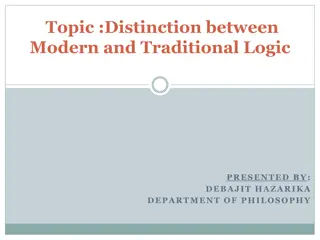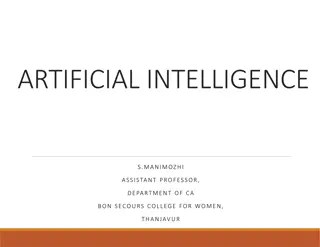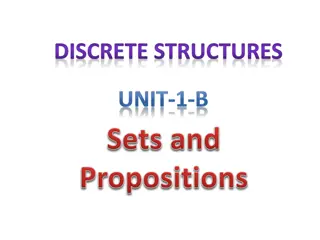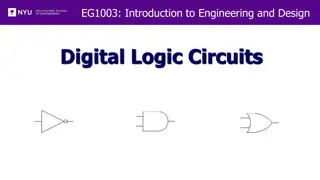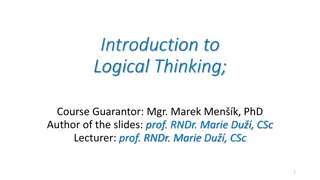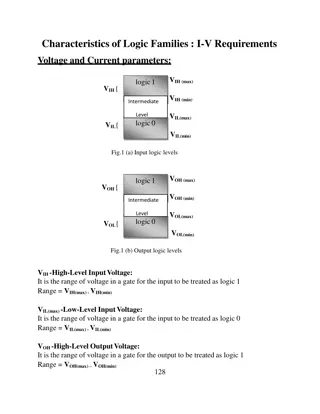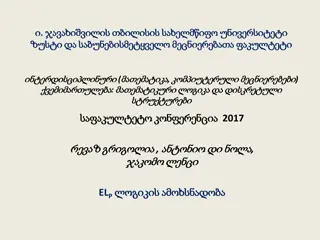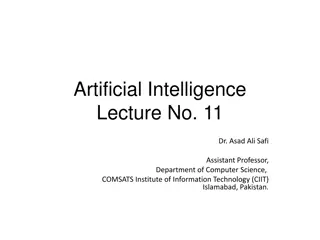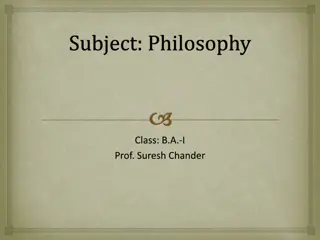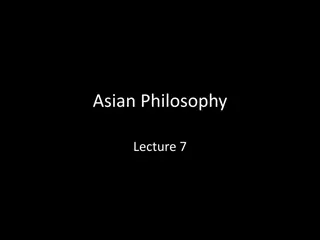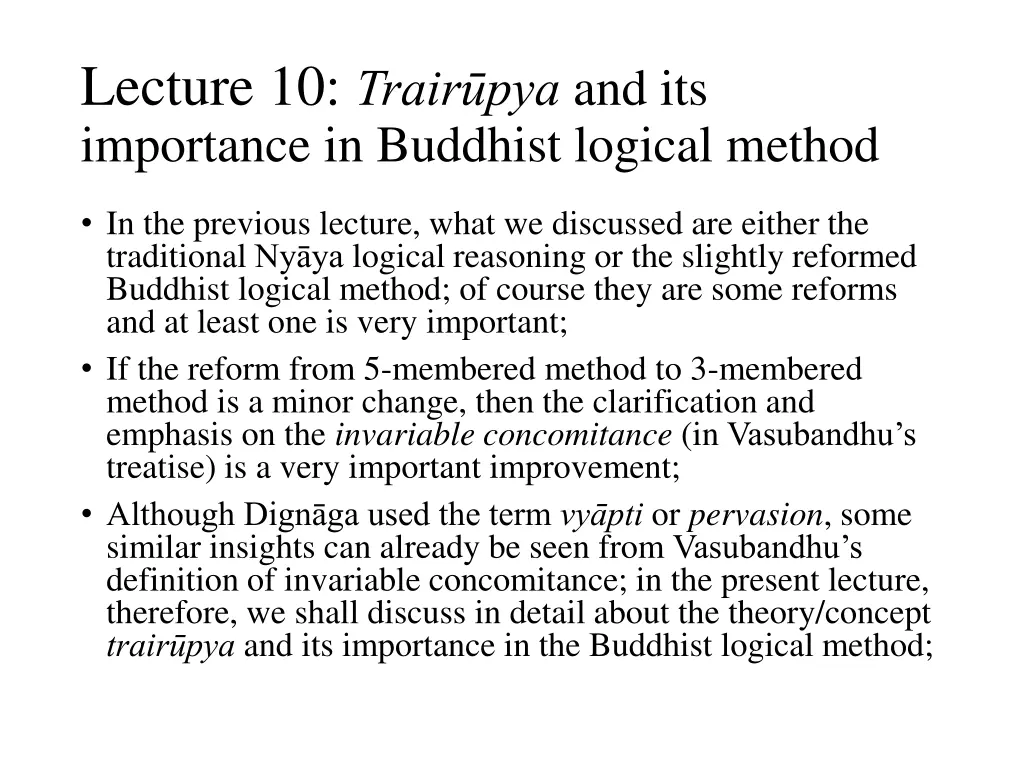
Importance of Trairpya in Buddhist Logical Method
Explore the significance of Trairpya in Buddhist logical method, focusing on invariable concomitance as seen in Vasubandhu's treatise. Learn how this concept establishes a constant relationship between phenomena, using examples like fire and smoke to illustrate the principle of exclusion and corroboration within Buddhist logical reasoning.
Download Presentation

Please find below an Image/Link to download the presentation.
The content on the website is provided AS IS for your information and personal use only. It may not be sold, licensed, or shared on other websites without obtaining consent from the author. If you encounter any issues during the download, it is possible that the publisher has removed the file from their server.
You are allowed to download the files provided on this website for personal or commercial use, subject to the condition that they are used lawfully. All files are the property of their respective owners.
The content on the website is provided AS IS for your information and personal use only. It may not be sold, licensed, or shared on other websites without obtaining consent from the author.
E N D
Presentation Transcript
Lecture 10: Trairpya and its importance in Buddhist logical method In the previous lecture, what we discussed are either the traditional Ny ya logical reasoning or the slightly reformed Buddhist logical method; of course they are some reforms and at least one is very important; If the reform from 5-membered method to 3-membered method is a minor change, then the clarification and emphasis on the invariable concomitance (in Vasubandhu s treatise) is a very important improvement; Although Dign ga used the term vy pti or pervasion, some similar insights can already be seen from Vasubandhu s definition of invariable concomitance; in the present lecture, therefore, we shall discuss in detail about the theory/concept trair pya and its importance in the Buddhist logical method;
Vasubandhus invariable concomitance As we discussed, invariable means constant and never changing; it suggests that it is not variable and therefore always the same; concomitance means that if one thing happens, the other would follow; so the two words together suggest that in a constant fashion, if one thing happens or exists, the other would follow or exist; As we mentioned many times, the key point of proving that fire can be inferred from smoke because whenever there is a fire, the would be smoke; it means that these two event would take place together always and constant, and as such, there is a relationship of invariable concomitance between these two events; this rule also applies to produced- ness/conditioned-ness and impermanence: whatever produced must be impermanent sound and pot;
Invariable concomitance: the example of fire and smoke; corroboration if one exists then the other exists;
Invariable concomitance: exclusion if one cesses, then the another follows; please notice that in Buddhist logical reasoning, here fire and smoke and the invariable concomitance of those two are just employed to show that in order to guarantee the validity of the thesis, fire and smoke will occur concomitantly and cease to exist constantly; in modern time, of course we know that there are occasions when there is a fire without smoke and vice versa; this observation also applies to the example of produced-ness and impermanent;
Trairpya: some further explanations Trair pya: instead of understanding the term as a concept, it might be helpful to understand it as a theory; in other words, the term means trai/three + r pa/matter = three matters, or it is generally translated as three characteristics of the hetu/reason; As we mentioned in the lecture notes, the discussion of the concept of the three aspects of the reason and the relationship between the thesis/subject and the reason can probably be dated back to the early Ny ya logical method, for as early as the time of Asa ga, he already made some criticism about the trair pya; his brother, despite being a contemporary, actually accepted the concept; But not until the time of Dign ga, he explicitly articulated some clear definitions of the concept as well as specified that the three characteristics of the reason are necessary;
Trairpya: below the diagram demonstrates the development of trair pya theory; please note that although from some translated fragmentary Chinese texts we are informed that Asa ga criticized the theory, while his brother Vasubandhu supported it, because of the difficulty in dating those sources, all we can be certain is that the theory developed before Dign ga but it was he who have clarified and made it a necessary condition for Buddhist logical reasoning; Transition period Dign ga Dharmak rti Trair pya Ny ya articulations Asa ga: criticism Vasubandhu: support/acceptance Possible early development Reform and refinement
Vypti: we shall first of all explain this term and some other related terms; although it is clear from the examples such as fire/smoke or sound/produced-ness/impermanent what the term means, by explaining further we may understand how the Buddhist method actually works; As we discussed, this term may not have been invented by Buddhist scholars, nor was it even an invention of Dign ga himself; in fact, according to Barlingay (Barlingay, 1965:109), sometimes Buddhist logicians actually used the term hetus dhyapratibandha or connection of the hetu/reason and the s dhya/the property of the subject; however, started from Dign ga, the term was treated like a theory rather than a mere concept, which expanded its definition; Vy pti: it means universal pervasion or similar to the invariable concomitance; and we shall provide two more related terms so that the term itself would be clearer; Vy paka: it means pervader, or probandum, or something that needs to be proved; here it means s dhya/property of the subject; Vy pya: this is another term derived from vy pti, which means pervaded, or probans, or the proof; here it means hetu/reason or li ga/sign/mark;
Vypti Vypya Vypaka: here, the vypaka is the thing that needs to be proved, and with the universal pervasion vy pti of the vy paka and vy pya proof/hetu/linga, the whole inference process is complete;
Example-1: Vypti Vypya Vypaka; please note that when we discussed the invariable concomitance, we suggests that fire + smoke = invariable concomitance; that is not a mathematical equation; rather it is a mere simplified illustration; below we shall use the chain of gears to demonstrate the mechanism of vy pti;
Example-2: below we are employing the other classical example to illustrate the working mechanism of the Vy pti Vy pya Vy paka; please note that while the previous fire & smoke example tries to prove the existence and locus of the event, the sound produced-ness & non-eternal is to prove the property of non-eternality/impermanence;
2ndcharacteristic: sapake sattvam, which means reason is present in the similar example; this aspect is rather straightforward, for as we mentioned on many early occasions, a similar example of smoke (and also fire; here remember the function of hetu/reason, which is sign/reason to qualify the property of the subject mountain on fire), would be present in a kitchen; when we discuss the 2ndcondition of the trair pya, please remember the first one or the v ypti; 2nd Example- 1 condition of the trair pya Hetu: smoke as a reason & sign of fire Sapak e sattvam Like in a kitchen, where both fire and smoke exist together or the existence of fire pervades smoke Hetu/ reason is present in the similar example
Example-2: please see below in the example of sound and its property of non- eternality; here, because of the v ypti, we know that sound is non-eternal due to it is produced; so in order to prove the validity of the hetu/reason/mark non-eternality because it is produced we need a example where reason and the property of produced-ness non- eternality, are both present; so both pot (example) and produced-ness (hetu/reason) share the similar property non-eternality; 2ndcondition of the trair pya Example-2 Hetu: produced- ness as a mark/reason of being non-eternal Sapak e sattvam Like in the case of a pot, which is both produced and non-eternal Hetu/reason is present in the similar example
3rdcondition/characteristic: now we come to the last and the third condition of the trair pya, which is vipak e asattvam, or absence in the dissimilar example; as you can see, asattvam is the negation prefix a + sattvam, which means absence or non-existence; so the term is straightforward; 3rdcondition of the trair pya Example-1 Vipak e a- sattvam Hetu: smoke as a reason of fire Here/reason must be absent from the dissimilar example Unlike in a lake, where fire and smoke must be absent
Example-2: as in the case of vipake sattvam, here the vipake asattvam is also straightforward, for because the role of vipak e asattvam is to exclude the possibility, a dissimilar example is given and its absence in the example is required; 3rd Example- 2 condition Hetu: produced-ness as a sign/mark of the non-eternality of sound or whatever of such things Vipak e a-sattvam Unlike in the case of the sky, which is neither produced nor non-eternal; Hetu/reason must be absent from the dissimilar example
How to paint a hidden monastery in the mountain? before ending this lecture, I shall tell you a story so that you will remember what we have discussed in this lecture! Once upon time, a great painter is asked to paint a hidden monastery in a mountain with some dense forests and other vegetations; generally, of course, we would think of painting a monastery, probably half hidden or mostly hidden but with part of it revealing somewhere; at least there must be some exposure of the monastery to reveal the existence of it; if that is what you think, it is fine, for that is what I would think of the situation; But for a creative artist, whose talents are not only painting skills, but also ingenuity and imagination, the requirement has to be addressed subtly and even more imaginatively; As such, there is actually no monastery on the painting; instead, a stone-paved trial is leading deep into the forest- covered mountain; amidst the stairs of the trail, a monk is carrying a pair of buckets with a pole on his shudder
A hidden monastery in the mountain: if there is a monk, the must be
Exercises/assignments #10 Do the following exercises and submit them via email (chuanqing@bcs.edu.sg) to me by 5:00 pm, on 11th November (Wednesday); as usual, please send the exercises of the two courses (Buddhism and Economics & Introduction to Buddhist Logic) together in one Word doc. file; 1, Can you provide an example of the 3-membered logical reasoning method? Again please do not use the classical example we have used and if possible, do not use what you have used before. Please create a new one this time. 2, Please identify the three aspects of the trair pya in the example you are asked to provide. In other words, which one is v ypti in your logical reasoning method in the question no. 1? Which one are the similar and dissimilar examples?

